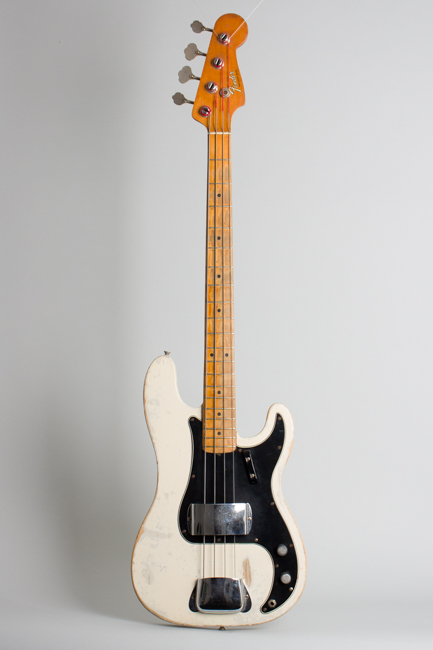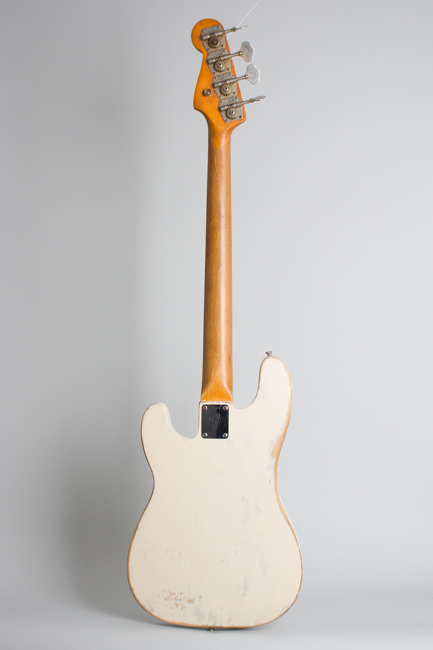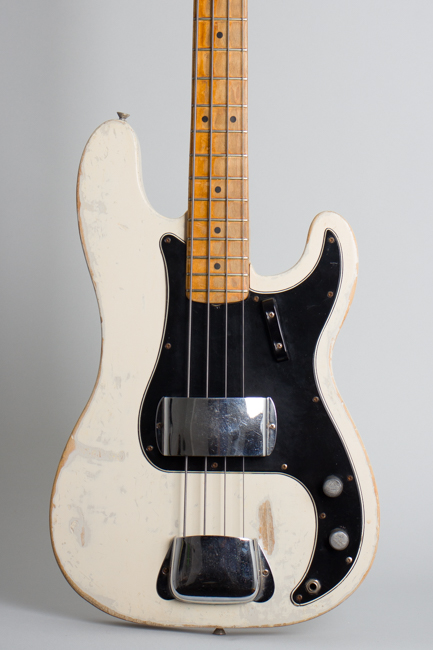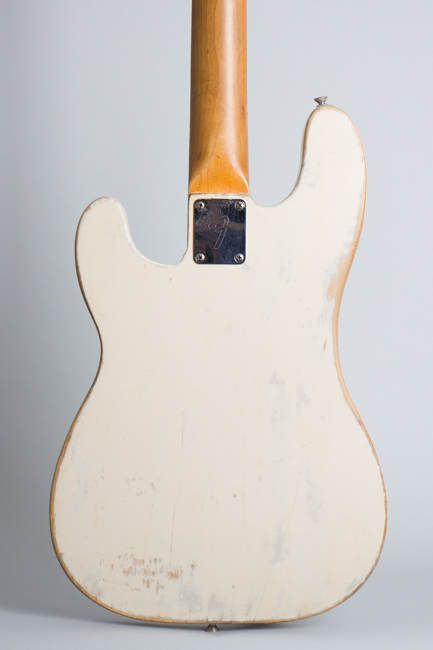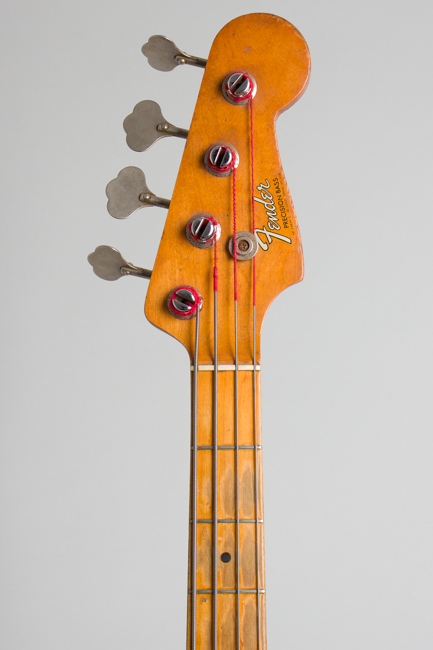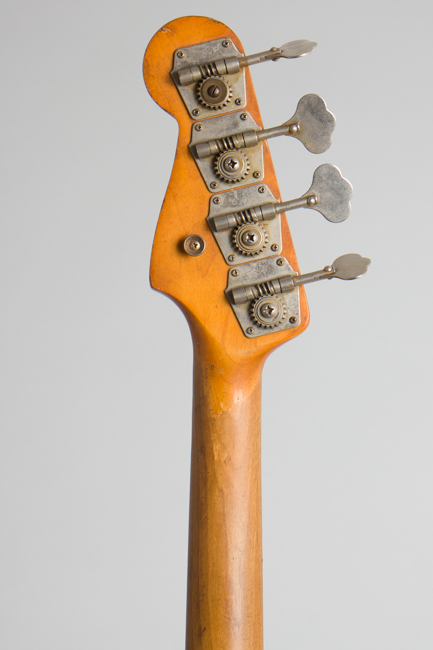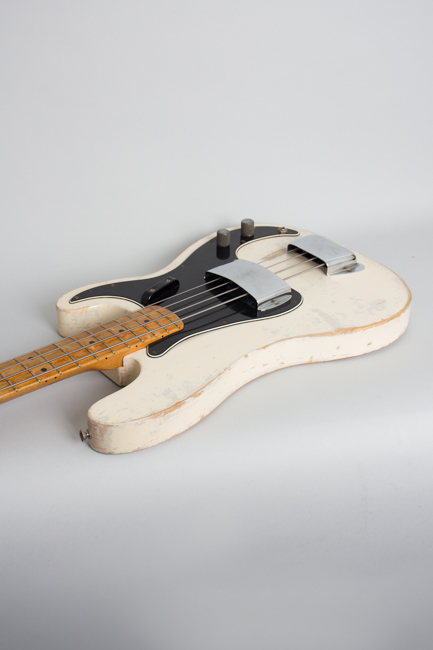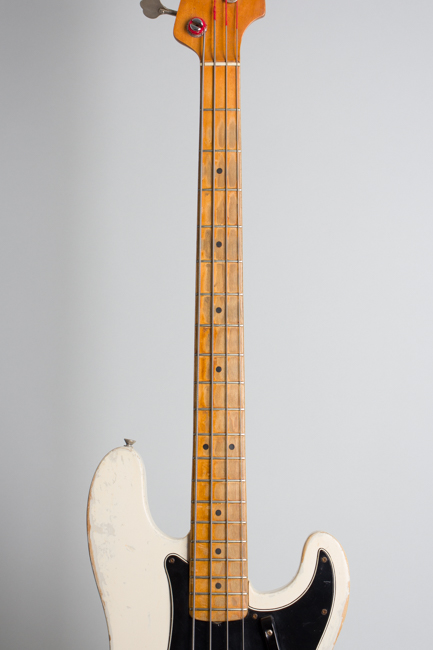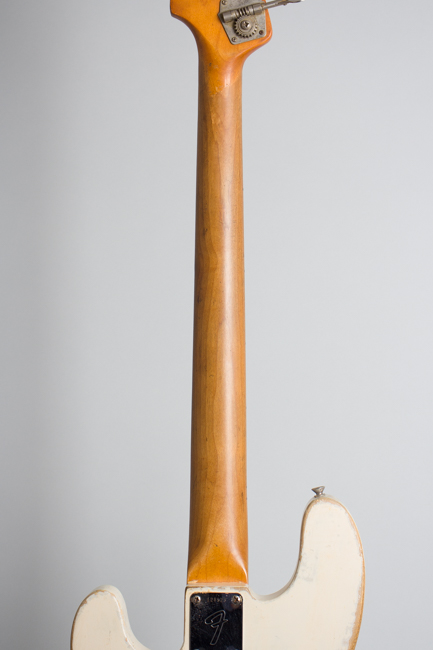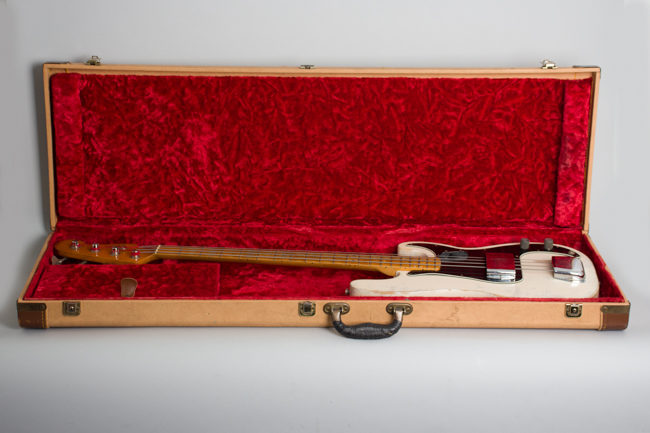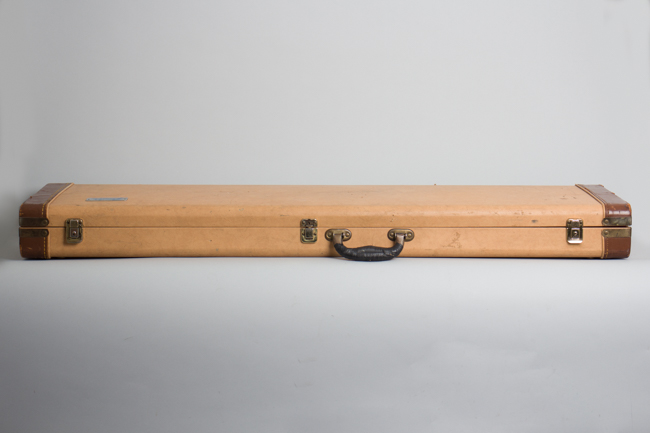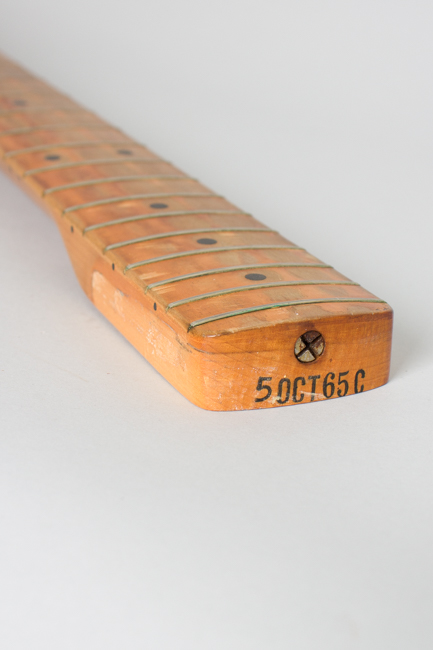Fender Slab Body Precision Solid Body Electric Bass Guitar (1966)
Fender Slab Body Precision Model Solid Body Electric Bass Guitar (1966), made in Fullerton, California, serial # 128929, white re- finish, Ash body, maple neck with maple fingerboard, brown hard shell case.
This instrument is one of the true legends of the Fender bass: a 1966 Slab-Body Precision. Long rumored, occasionally sighted, even a refinished example like this is a veritable white whale. Compared to a stock 1966 Precision bass, these instruments have the crucial difference: an uncontoured ash body, Telecaster style. The neck features a laid-on maple fingerboard, a seldom seen custom-order feature. While never catalogued or formally advertised, two very small batches of these were assembled in 1966.
Ivor Arbiter, Fender's UK distributor in 1966 casually announced a "New type of Fender bass with a Telecaster-type body" in early summer that year. The initial run was sold exclusively in the UK; Arbiter have no record of how many they imported but estimates 25 at most. This bass is one of those. WHY this combination of features was chosen, and by whom is unknown. It could be the result of a 1952 Precision bass being described to someone at Arbiter (or Fender) who had never seen one! The original UK run had a blonde slab ash body, maple neck, and black pickguard, salient features of the first Fender basses but constructed with new-style parts.
By 1966 interest in older instruments had already begun, likely these basses represent an early attempt at a "re-issue". Within a year Fender had gone whole hog with the actual "Telecaster Bass", a more accurate recreation of a 1952 instrument; these 1966 "slabs" seem a tentative first step. A second smaller "slab" run assembled from leftover parts were shipped out of Fullerton as "off-stock" items in late '66 and early '67, but these lack the black guard and in some cases the maple neck.
In England a number of top bassists adopted these "slabs" right away, notably John Entwistle of the Who and Ace Kefford of the Move. They were referred to at the time as the "Telecaster Bass" in the UK, despite the decal reading "Precision". Eric Haydock of the Hollies bought one and others popped up in the Tremeloes, the Amen Corner, the Plommons (in Sweden) and in the US with Skip Battin of the Byrds and Larry Taylor of Canned Heat. Later Steve Currie of T-Rex appeared with one, as did Gary Glitter's Glitter Band. Several of these (including Entwistle's originals and Tremolo Chip Hawkes') are known to have been destroyed.
This bass (serial number 128929) is a fully documented example, listed in the book "Fender Bass for Britain" by the late Barry Matthews solely dedicated to these models. The serial number is the lowest recorded, but the neck date of September 1965 is not the oldest; many of the first run were assembled with older maple-capped necks held in stick at Fender. The pots date to spring 1966, when the first run was assembled. The bass was sold some years ago from the semi-legendary Andy's in London's Denmark Street and more recently re-surfaced in Sweden. Even well used with a body-only refinish this is one of the rarest (and coolest) Fender basses in existence.
Overall length is 46 in. (116.8 cm.), 13 in. (33 cm.) wide at lower bout, and 1 5/8 in. (4.1 cm.) in depth, measured at side of rim. Scale length is 34 in. (864 mm.). Width of nut is 1 3/4 in. (44 mm.).
This bass must have had an interesting life over 55+ tears so far; it certainly shows evidence of years of serious play time. The body finish is old and has the correct look but is not original; it is an aged white/blonde lacquer with a grey undercoat and appears to date to the 1970s. A large percentage of these very rare "slabs" appear to have been similarly refinished "back in the day" as the original blonde lacquer tended to rapidly wear off the sharp body edges. This one has seen a LOT of use since then; the body finish is heavily worn into and through the undercoat with some light chipping and rounding off of the edges. The neck finish is all original, worn down heavily on both the back of the neck and the fingerboard.
The hardware remains original (One tuner post screw has been replaced) showing wear commensurate with the use the bass exhibits. This includes the impossibly rare black laminated pickguard, ONLY ever used on the 25 or so examples of these originally shipped to Arbiter in England; this has one small split at the rearmost screw hole. The bridge saddles have considerable corrosion and are currently locked in place; these could of course be easily replaced if desired but the set up and intonation are solid as it stands. A small extra ground was added to the volume pot, but the pickups and electronics are otherwise original.
The frets appear original and unsurprisingly are crowned down very low, even so the bass still plays well and sounds simply amazing, just as John Entwistle himself observed the "growl' of the slab is something unique. We usually set up older Fender basses with flat wound strings these days but this one carries a set of vintage Roto sound "Swing Bass" with the exact "Entwistle '66" sound. Even allowing for the refinish this is an amazing, exceptionally rare "genuine relic" instrument that would be a jewel in any Fender collection. It resided in an interesting Export-style Fender-branded case with some old paper materials regarding the history of the "slabs" thrown in. Overall Very Good + Condition.
This instrument is one of the true legends of the Fender bass: a 1966 Slab-Body Precision. Long rumored, occasionally sighted, even a refinished example like this is a veritable white whale. Compared to a stock 1966 Precision bass, these instruments have the crucial difference: an uncontoured ash body, Telecaster style. The neck features a laid-on maple fingerboard, a seldom seen custom-order feature. While never catalogued or formally advertised, two very small batches of these were assembled in 1966.
Ivor Arbiter, Fender's UK distributor in 1966 casually announced a "New type of Fender bass with a Telecaster-type body" in early summer that year. The initial run was sold exclusively in the UK; Arbiter have no record of how many they imported but estimates 25 at most. This bass is one of those. WHY this combination of features was chosen, and by whom is unknown. It could be the result of a 1952 Precision bass being described to someone at Arbiter (or Fender) who had never seen one! The original UK run had a blonde slab ash body, maple neck, and black pickguard, salient features of the first Fender basses but constructed with new-style parts.
By 1966 interest in older instruments had already begun, likely these basses represent an early attempt at a "re-issue". Within a year Fender had gone whole hog with the actual "Telecaster Bass", a more accurate recreation of a 1952 instrument; these 1966 "slabs" seem a tentative first step. A second smaller "slab" run assembled from leftover parts were shipped out of Fullerton as "off-stock" items in late '66 and early '67, but these lack the black guard and in some cases the maple neck.
In England a number of top bassists adopted these "slabs" right away, notably John Entwistle of the Who and Ace Kefford of the Move. They were referred to at the time as the "Telecaster Bass" in the UK, despite the decal reading "Precision". Eric Haydock of the Hollies bought one and others popped up in the Tremeloes, the Amen Corner, the Plommons (in Sweden) and in the US with Skip Battin of the Byrds and Larry Taylor of Canned Heat. Later Steve Currie of T-Rex appeared with one, as did Gary Glitter's Glitter Band. Several of these (including Entwistle's originals and Tremolo Chip Hawkes') are known to have been destroyed.
This bass (serial number 128929) is a fully documented example, listed in the book "Fender Bass for Britain" by the late Barry Matthews solely dedicated to these models. The serial number is the lowest recorded, but the neck date of September 1965 is not the oldest; many of the first run were assembled with older maple-capped necks held in stick at Fender. The pots date to spring 1966, when the first run was assembled. The bass was sold some years ago from the semi-legendary Andy's in London's Denmark Street and more recently re-surfaced in Sweden. Even well used with a body-only refinish this is one of the rarest (and coolest) Fender basses in existence.
Overall length is 46 in. (116.8 cm.), 13 in. (33 cm.) wide at lower bout, and 1 5/8 in. (4.1 cm.) in depth, measured at side of rim. Scale length is 34 in. (864 mm.). Width of nut is 1 3/4 in. (44 mm.).
This bass must have had an interesting life over 55+ tears so far; it certainly shows evidence of years of serious play time. The body finish is old and has the correct look but is not original; it is an aged white/blonde lacquer with a grey undercoat and appears to date to the 1970s. A large percentage of these very rare "slabs" appear to have been similarly refinished "back in the day" as the original blonde lacquer tended to rapidly wear off the sharp body edges. This one has seen a LOT of use since then; the body finish is heavily worn into and through the undercoat with some light chipping and rounding off of the edges. The neck finish is all original, worn down heavily on both the back of the neck and the fingerboard.
The hardware remains original (One tuner post screw has been replaced) showing wear commensurate with the use the bass exhibits. This includes the impossibly rare black laminated pickguard, ONLY ever used on the 25 or so examples of these originally shipped to Arbiter in England; this has one small split at the rearmost screw hole. The bridge saddles have considerable corrosion and are currently locked in place; these could of course be easily replaced if desired but the set up and intonation are solid as it stands. A small extra ground was added to the volume pot, but the pickups and electronics are otherwise original.
The frets appear original and unsurprisingly are crowned down very low, even so the bass still plays well and sounds simply amazing, just as John Entwistle himself observed the "growl' of the slab is something unique. We usually set up older Fender basses with flat wound strings these days but this one carries a set of vintage Roto sound "Swing Bass" with the exact "Entwistle '66" sound. Even allowing for the refinish this is an amazing, exceptionally rare "genuine relic" instrument that would be a jewel in any Fender collection. It resided in an interesting Export-style Fender-branded case with some old paper materials regarding the history of the "slabs" thrown in. Overall Very Good + Condition.
